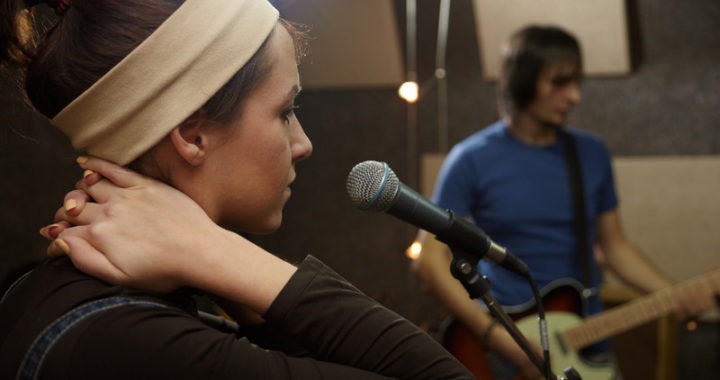Melodic range refers to the interval between your song’s lowest and highest note. It may not seem all that important to the success of a song, but melodic range (by which we eventually mean vocal range) can play a role in how audiences hear melodies, and be important regarding to how easily those melodies are remembered.
Each section of a song is a separate entity that then needs to communicate with the other sections of that song, so it makes sense that we look at the various melodies a song offers and assess range issues separately.
 Having trouble diagnosing the problem with your latest song? “Fix Your Songwriting Problems – NOW!” takes a good look at seven of the most common problems songwriters have dealt with over the past few decades of pop music. With solutions you can apply to your song right now.
Having trouble diagnosing the problem with your latest song? “Fix Your Songwriting Problems – NOW!” takes a good look at seven of the most common problems songwriters have dealt with over the past few decades of pop music. With solutions you can apply to your song right now.
Verse melodies usually feature the song’s lowest notes and most constricted range, and the chorus usually displays the highest notes. Those highest notes often happen right at, or near, the start of the chorus. Maroon 5’s “Payphone” is a good example of this.
A bridge might contain the song’s highest notes, if that bridge is used to pump up the song’s musical energy. But what’s really important about melodic range?
Range and Singability
As you work out your song, you’re instinctively thinking about range all the time, because range relates to basic singability: you’ll struggle with a melody that’s too high in pitch. The same is true for melodies that are too low, though pop music genres tend to push melodies into the upper regions of the singer’s vocal range.
So your instincts might tell you to move a melody up or down until it sits more or less in the middle of your range, but that’s not always the wisest course of action. A chorus in an emotionally powerful song, such as The Beatles’ “Golden Slumbers” would not have the same impact if the melody were placed lower in pitch. In most songs, upper range singing intensifies the emotional aspect of the song.
Range and Memorability
We’ve been talking about range with regard to a song’s highest notes, but when it comes to how easily or not an audience remembers a melody, the actual span of the range — the interval of the lowest to highest note — can play a vital role.
Audiences will have an easier time remembering melodies that have a smaller range, because the smaller the range, the more likely repetition is going to be an important organizing feature. In “Man in the Mirror” (Siedah Garrett, Glen Ballard, recorded by Michael Jackson), the chorus uses the range of a 6th, and repetition (both exact and approximate) plays a very important role.
Smaller ranges also makes it easier for people to sing along, of course, and so it makes sense that chorus hooks use a somewhat restricted range.
Expanding a Song’s Range
Some songs work well with a very small range. It usually leads to restricted melodic cells (not necessarily in a bad way) which can have a meditative effect on an audience, much like the verse of Tom Petty’s “Free Fallin’.” And so if that’s working for your song, that’s great.
But if you find that any of your song’s melodies sound mundane or uninteresting, it could be that the range is simply too restricted. Some tips:
- Look for ways to expand the range. Most of the time, this will mean finding a moment to move a melody’s high point even higher. Moving low notes lower tends to not have a great impact, unless you’re talking about a verse melody that sits in the same range as your chorus (see point #3 below).
- Don’t be afraid of your high range. Even if you have to strain to get those higher notes, a bit of strain (within reason) can add to the emotional power and meaning of your lyric.
- Avoid using identical ranges in adjacent song sections. If your verse melody and chorus melody both sit in the octave between Middle C and the C above it, the lack of variation in range will usually result in something that sounds boring to an audience. Move your verse down or your chorus up, or both.
 Written by Gary Ewer. Follow Gary on Twitter.
Written by Gary Ewer. Follow Gary on Twitter.
 “The Essential Secrets of Songwriting” 10- eBook bundle comes with a free copy of “Creative Chord Progressions”. Learn how to take your chords beyond simple I-IV-V progressions. With pages of examples ready for you to use in your own songs.
“The Essential Secrets of Songwriting” 10- eBook bundle comes with a free copy of “Creative Chord Progressions”. Learn how to take your chords beyond simple I-IV-V progressions. With pages of examples ready for you to use in your own songs.











Hi Gary! Excellent article! A good range is definitely a main focal point in a melody and research has shown that revealing the full range of the melody earlier on rather than saving it for the chorus is common amongst well written songs. Usually a minimum of 12 semitones, and for the most compelling (yet still singable!) for the majority of performers around an octave and perhaps a few more semitones. Additional vocal gymnastics can add aesthetics as the performer sees fit, but care has to be taken that the intent of the melody isn’t blurred. The list of song examples and evidence explained will be revealed in that upcoming book I mentioned: https://www.songmatrix.com/PGS/research_overview.html